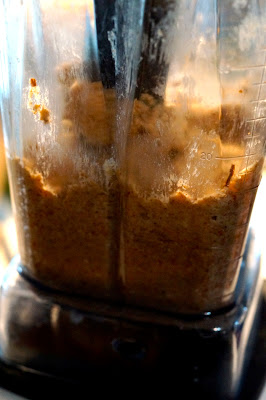 Mmmmm... Almond butter! Such divinely yummy stuff!
Mmmmm... Almond butter! Such divinely yummy stuff!Since we virtually never eat bread, we don't have many occasions to use it as a spread, but we do like it sometimes as a dessert treat on rice cakes with honey and a sprinkle of cinnamon. Almond butter can also come in super handy for making a last minute Almond Milk; just blend one tablespoon or so with some water, and there you have it! Oh, and let's not forget how it's an essential component for sauces like my Pad Thai or Satay dishes.
As you know, since commercially sold almonds now have to be pasteurized by law, we can no longer trust that almonds and other almond products on the shelves of our favorite health food stores are raw in spite of what the labels say. We can find 'truly raw' almond butter at specialty stores such as The Raw Food World, but it can be very pricey.
Of course, I've fantasized about making it myself before, but the only way I'd heard of was in a food processor; a technique that can take many minutes with several pauses to avoid the motor from overheating.
I was therefore thrilled when our host Matthew offered to show me how he makes his own in his Vitamix blender.
Matthew's Scrumptious Homemade Raw Almond Butter
Yields: one 16 oz jar
Step 1: Soak your almonds overnight. You'll want at least 4 cups so that there's sufficient volume for the blender to process them properly. (Your final quantity will roughly reduce by half.)
By the way, Matt shared with me his favorite source for organic raw almonds: Bremner Farms. The price drops down to $7/lb when you order 30 lbs - a fab deal! We had no trouble getting to that amount by asking some of Matt's friends if they wanted to join in.
Step 2: Rinse your soaked almonds under fresh water then dehydrate them until completely dry. This can take anywhere from 24 to 48 hrs depending on what temp you use and the atmospheric conditions. You can tell that the almonds are ready when there is no discoloration at the ends when you break them between your fingers, and when they're nice and crunchy.
Step 3: Place your dehydrated almonds in a quart glass Mason jar (or any other container sealed from moisture) in the freezer for several hours, preferably overnight.
Step 4: Now this is where the fun begins...
Transfer your frozen almonds to the container of your high-power blender and blend. Matt suggests to do it right away as the almonds will start pulling moisture out of the air if they're left at room temperature. You want the blender to be on maximum speed and will need the help of a tamper to ensure that there are no air pockets and that the blades can do their job of completely breaking down the almonds' fibers.
Here you can see how the almonds are beginning to release their oils.
You'll most likely have to stop at least once during the process in order to pry away any bits of dry almonds stuck to the sides of the container. A chopstick works well for that.
When you start the blender again you'll want to go at a lower speed so as to reintegrate those chunks. Bear in mind not to run it on low for too long, though, as it will overheat the machine. Switch it back to high speed as soon as the almond bits are incorporated.
After a couple of minutes or so of processing you'll want to start monitoring the temperature, as the mixture will start heating up. This is why it's an essential step to put the almonds in the freezer first so that they don't do so as quickly.
Matt has an infrared thermometer which he uses to determine the temp of his food. I can see how such a little tool can be soooo useful for all sorts of things: melting cacao butter and coconut oil, making soup, cheeze or coconut yogurt, dehydrating goodies... you name it! In fact we've ordered one from Amazon although it's a slightly different model.
Actually at this point we decided to pop the blender container into the freezer to allow the almond mixture to cool down a little. You don't want to leave the container longer than 15 - 20 mins or the butter will start sticking to the sides.
Then blend again, still on high, to really make sure that all of the nut pieces are completely broken down. If it won't mix on high due to too much air going in, you can bring the speed down using the control dial for a bit.
Stop when you've reached the texture that you're looking for. We like our butter nice and smooth...
Be-yu-ti-ful!
Step 5: Time to transfer your freshly homemade almond butter to a glass jar. It should keep for at least several months in the refrigerator (or the freezer), but I doubt that it will last that long! ;-)
Voila! The BEST raw almond butter EVER!
One final note: Matthew reminds me that it's not an exact science; it's for us to get a feel for the process and determine what works best.
I'm sure looking forward to perfecting my technique to whip up decadent homemade raw almond butter. Yay!
What about you? Have you ever tried making your own nut butter from scratch?



























I've been an occasional gawker but haven't commented before: I'm here admiring your huge generosity and bounteous spirit. Thank you for sharing ideas, which are the true currency in these times, and also paying it forward by sharing the information of places like the nut farm that so many of us would like to know about.
ReplyDeleteMany blessings,
Ela
Thanks so much for your sweet words of appreciation. They warm my heart. ;-)
DeleteI just made some in the omniblender. This is awesome Carmella, thank you.
ReplyDeleteOh cool! Glad to know that this technique works in the Omni as well. Yippee!
DeleteWhat does the freezing do? Just curious.
ReplyDeleteFreezing the almonds beforehand prevents them from overheating too quickly. There's still a chance that you may have to stop and place the container in the freezer to cool off in the process but it gives you a good head start. Otherwise you'd end up with 'not-so-raw' almond butter. ;-)
DeleteI hope it all goes smoothly if you decide to make it! I'll be whipping myself a batch this coming week...